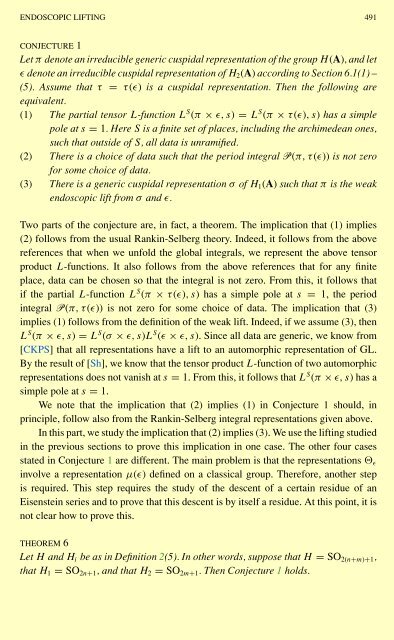A NULLSTELLENSATZ FOR AMOEBAS
A NULLSTELLENSATZ FOR AMOEBAS
A NULLSTELLENSATZ FOR AMOEBAS
You also want an ePaper? Increase the reach of your titles
YUMPU automatically turns print PDFs into web optimized ePapers that Google loves.
ENDOSCOPIC LIFTING 491<br />
CONJECTURE 1<br />
Let π denote an irreducible generic cuspidal representation of the group H (A), and let<br />
ɛ denote an irreducible cuspidal representation of H 2 (A) according to Section 6.1(1) –<br />
(5). Assume that τ = τ(ɛ) is a cuspidal representation. Then the following are<br />
equivalent.<br />
(1) The partial tensor L-function L S (π × ɛ, s) = L S (π × τ(ɛ),s) has a simple<br />
pole at s = 1.HereS is a finite set of places, including the archimedean ones,<br />
such that outside of S, all data is unramified.<br />
(2) There is a choice of data such that the period integral P(π, τ(ɛ)) is not zero<br />
for some choice of data.<br />
(3) There is a generic cuspidal representation σ of H 1 (A) such that π is the weak<br />
endoscopic lift from σ and ɛ.<br />
Two parts of the conjecture are, in fact, a theorem. The implication that (1) implies<br />
(2) follows from the usual Rankin-Selberg theory. Indeed, it follows from the above<br />
references that when we unfold the global integrals, we represent the above tensor<br />
product L-functions. It also follows from the above references that for any finite<br />
place, data can be chosen so that the integral is not zero. From this, it follows that<br />
if the partial L-function L S (π × τ(ɛ),s) has a simple pole at s = 1, the period<br />
integral P(π, τ(ɛ)) is not zero for some choice of data. The implication that (3)<br />
implies (1) follows from the definition of the weak lift. Indeed, if we assume (3), then<br />
L S (π × ɛ, s) = L S (σ × ɛ, s)L S (ɛ × ɛ, s). Since all data are generic, we know from<br />
[CKPS] that all representations have a lift to an automorphic representation of GL.<br />
By the result of [Sh], we know that the tensor product L-function of two automorphic<br />
representations does not vanish at s = 1. From this, it follows that L S (π × ɛ, s) has a<br />
simple pole at s = 1.<br />
We note that the implication that (2) implies (1) in Conjecture 1 should, in<br />
principle, follow also from the Rankin-Selberg integral representations given above.<br />
In this part, we study the implication that (2) implies (3). We use the lifting studied<br />
in the previous sections to prove this implication in one case. The other four cases<br />
stated in Conjecture 1 are different. The main problem is that the representations ɛ<br />
involve a representation µ(ɛ) defined on a classical group. Therefore, another step<br />
is required. This step requires the study of the descent of a certain residue of an<br />
Eisenstein series and to prove that this descent is by itself a residue. At this point, it is<br />
not clear how to prove this.<br />
THEOREM 6<br />
Let H and H i be as in Definition 2(5). In other words, suppose that H = SO 2(n+m)+1 ,<br />
that H 1 = SO 2n+1 , and that H 2 = SO 2m+1 . Then Conjecture 1 holds.
















